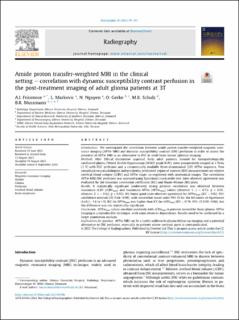| dc.contributor.author | Friismose, Ancuta | |
| dc.contributor.author | Nguyen, Nina | |
| dc.contributor.author | Markovic, Ljubo | |
| dc.contributor.author | Gerke, Oke | |
| dc.contributor.author | Schultz, Mette | |
| dc.contributor.author | Mussmann, Bo | |
| dc.date.accessioned | 2022-02-07T10:07:32Z | |
| dc.date.available | 2022-02-07T10:07:32Z | |
| dc.date.created | 2021-09-09T15:47:43Z | |
| dc.date.issued | 2021-01-07 | |
| dc.identifier.issn | 1078-8174 | |
| dc.identifier.issn | 1532-2831 | |
| dc.identifier.uri | https://hdl.handle.net/11250/2977427 | |
| dc.description.abstract | Introduction: We investigated the correlation between amide proton transfer-weighted magnetic resonance imaging (APTw MRI) and dynamic susceptibility contrast (DSC) perfusion in order to assess the potential of APTw MRI as an alternative to DSC in adult brain tumor (glioma) imaging.
Methods: After Ethical Committee approval, forty adult patients, treated for histopathologically confirmed glioma (World Health Organization (WHO) grade II-IV), were prospectively imaged at 3 Tesla (3 T) with DSC perfusion and a commercially available three-dimensional (3D) APTw sequence. Two consultant neuroradiologists independently performed region of interest (ROI) measurements on relative cerebral blood volume (rCBV) and APTw maps, co-registered with anatomical images. The correlation APTw MRI-DSC perfusion was assessed using Spearman's rank-order test. Inter-observer agreement was evaluated by the intraclass correlation coefficient (ICC) and Bland-Altman (BA) plots.
Results: A statistically significant moderately strong positive correlation was observed between maximum rCBV (rCBVmax) and maximum APTw (APTwmax) values (observer 1: r ¼ 0.73; p < 0.01; observer 2: r ¼ 0.62; p < 0.01). We found good inter-observer agreement for APTwmax (ICC ¼ 0.82; 95% confidence interval (CI) 0.66e0.90), with somewhat broad outer 95% CI for the BA Limits of Agreement (LoA) (-1.6 to 1.9). ICC for APTwmax was higher than ICC for rCBVmax (ICC ¼ 0.74; 95%; CI 0.50e0.86), but the difference was not statistically significant.
Conclusion: APTwmax values correlate positively with rCBVmax in patients treated for brain glioma. APTw imaging is a reproducible technique, with some observer dependence. Results need to be confirmed by a larger population analysis.
Implications for practice: APTw MRI can be a useful addition to glioma follow-up imaging and a potential alternative to DSC perfusion, especially in patients where contrast agent is contraindicated. | en_US |
| dc.language.iso | eng | en_US |
| dc.publisher | Elsevier | en_US |
| dc.relation.ispartofseries | Radiography;Volume 28, Issue 1 | |
| dc.rights | Navngivelse 4.0 Internasjonal | * |
| dc.rights.uri | http://creativecommons.org/licenses/by/4.0/deed.no | * |
| dc.subject | Magnetic resonance imaging | en_US |
| dc.subject | Amides | en_US |
| dc.subject | Glioma | en_US |
| dc.subject | Perfusion | en_US |
| dc.subject | Cerebral blood volumes | en_US |
| dc.subject | Brain neoplasms | en_US |
| dc.title | Amide proton transfer-weighted MRI in the clinical setting – correlation with dynamic susceptibility contrast perfusion in the post-treatment imaging of adult glioma patients at 3T | en_US |
| dc.type | Peer reviewed | en_US |
| dc.type | Journal article | en_US |
| dc.description.version | publishedVersion | en_US |
| dc.rights.holder | © 2021 The College of Radiographers | en_US |
| cristin.ispublished | true | |
| cristin.fulltext | postprint | |
| cristin.qualitycode | 1 | |
| dc.identifier.doi | https://doi.org/10.1016/j.radi.2021.08.006 | |
| dc.identifier.cristin | 1932918 | |
| dc.source.journal | Radiography | en_US |
| dc.source.volume | 28 | en_US |
| dc.source.issue | 1 | en_US |
| dc.source.pagenumber | 95-101 | en_US |

